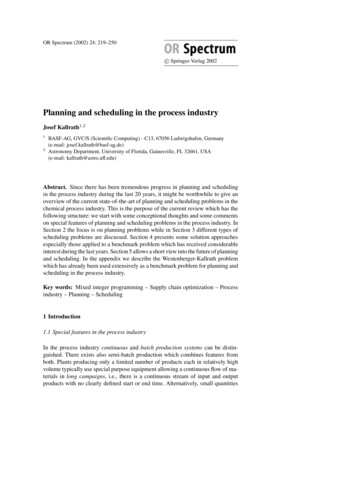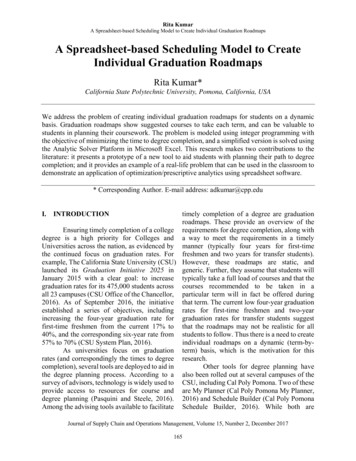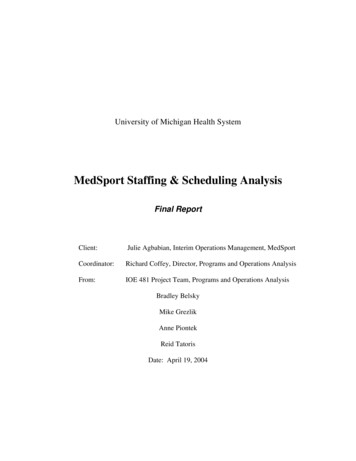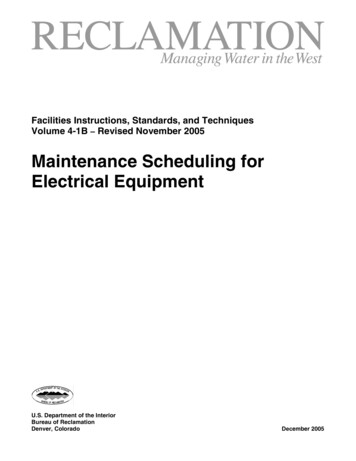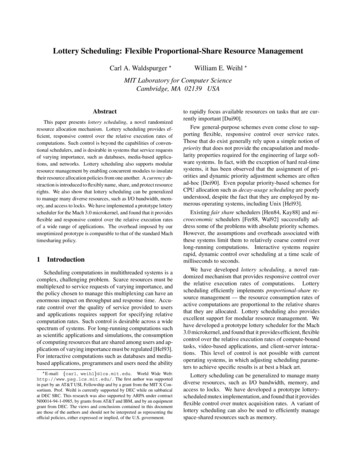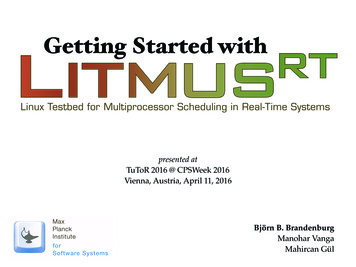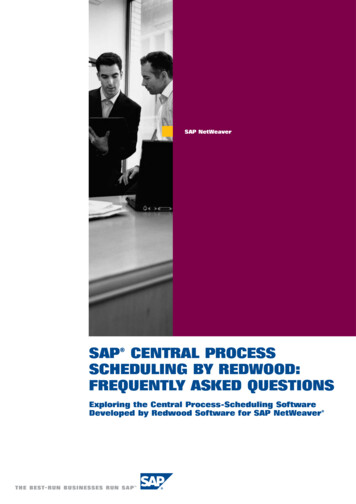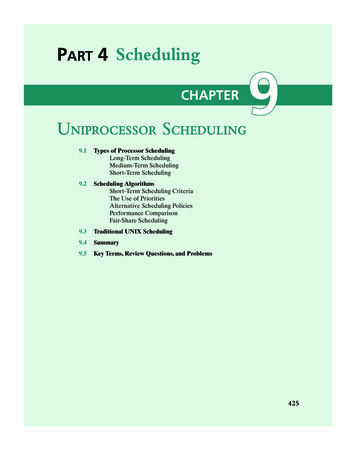
Transcription
Part 4 SchedulingChapterUniprocessor Scheduling9.1Types of Processor SchedulingLong-Term SchedulingMedium-Term SchedulingShort-Term Scheduling9.2Scheduling AlgorithmsShort-Term Scheduling CriteriaThe Use of PrioritiesAlternative Scheduling PoliciesPerformance ComparisonFair-Share Scheduling9.3Traditional UNIX Scheduling9.4Summary9.5Key Terms, Review Questions, and Problems425M09 STAL4290 09 GE C09.indd 4255/9/17 4:45 PM
426 Chapter 9 / Uniprocessor SchedulingLearning ObjectivesAfter studying this chapter, you should be able to: Explain the differences among long-, medium-, and short-term scheduling. Assess the performance of different scheduling policies. Understand the scheduling technique used in traditional UNIX.In a multiprogramming system, multiple processes exist concurrently in main memory. Each process alternates between using a processor and waiting for some eventto occur, such as the completion of an I/O operation. The processor or processors arekept busy by executing one process while the others processes wait.The key to multiprogramming is scheduling. In fact, four types of schedulingare typically involved (see Table 9.1). One of these, I/O scheduling, will be moreconveniently addressed in Chapter 11, where I/O is discussed. The remaining threetypes of scheduling, which are types of processor scheduling, will be addressed inthis chapter and the next.This chapter begins with an examination of the three types of processor scheduling, showing how they are related. We see that long-term scheduling and mediumterm scheduling are driven primarily by performance concerns related to the degreeof multiprogramming. These issues are dealt with to some extent in Chapter 3, andin more detail in Chapters 7 and 8. Thus, the remainder of this chapter concentrateson short-term scheduling and is limited to a consideration of scheduling on a uniprocessor system. Because the use of multiple processors adds additional complexity, itis best to focus on the uniprocessor case first, so the differences among schedulingalgorithms can be clearly seen.Section 9.2 looks at the various algorithms that may be used to make short-termscheduling decisions.9.1 TYPES OF PROCESSOR SCHEDULINGThe aim of processor scheduling is to assign processes to be executed by the processoror processors over time, in a way that meets system objectives, such as response time,throughput, and processor efficiency. In many systems, this scheduling activity is broken down into three separate functions: long-, medium-, and short-term scheduling.The names suggest the relative time scales with which these functions are performed.Table 9.1 Types of SchedulingLong-term schedulingThe decision to add to the pool of processes to be executed.Medium-term schedulingThe decision to add to the number of processes that are partially or fully in mainmemory.Short-term schedulingThe decision as to which available process will be executed by the processor.I/O schedulingThe decision as to which process’s pending I/O request shall be handled by anavailable I/O device.M09 STAL4290 09 GE C09.indd 4265/9/17 4:45 PM
9.1 / TYPES OF PROCESSOR SCHEDULING endFigure BlockedScheduling and Process State TransitionsFigure 9.1 relates the scheduling functions to the process state transition diagram (first shown in Figure 3.9b). Long-term scheduling is performed when a newprocess is created. This is a decision whether to add a new process to the set of processes that are currently active. Medium-term scheduling is a part of the swappingfunction. This is a decision whether to add a process to those that are at least partially in main memory and therefore available for execution. Short-term schedulingis the actual decision of which ready process to execute next. Figure 9.2 reorganizesthe state transition diagram of Figure 3.9b to suggest the nesting of schedulingfunctions.Scheduling affects the performance of the system because it determines whichprocesses will wait, and which will progress. This point of view is presented in Figure 9.3,which shows the queues involved in the state transitions of a process.1 Fundamentally,scheduling is a matter of managing queues to minimize queueing delay and to optimize performance in a queueing environment.Long-Term SchedulingThe long-term scheduler determines which programs are admitted to the system forprocessing. Thus, it controls the degree of multiprogramming. Once admitted, a job oruser program becomes a process and is added to the queue for the short-term scheduler. In some systems, a newly created process begins in a swapped-out condition, inwhich case it is added to a queue for the medium-term scheduler.In a batch system, or for the batch portion of an OS, newly submitted jobs arerouted to disk and held in a batch queue. The long-term scheduler creates processesfrom the queue when it can. There are two decisions involved. The scheduler must1For simplicity, Figure 9.3 shows new processes going directly to the Ready state, whereas Figures 9.1and 9.2 show the option of either the Ready state or the Ready/Suspend state.M09 STAL4290 09 GE C09.indd 4275/9/17 4:45 PM
428 Chapter 9 / Uniprocessor SchedulingRunningReadyBlockedShort termBlocked,suspendReady,suspendMedium termLong termNewFigure 9.2ExitLevels of Schedulingdecide when the OS can take on one or more additional processes. And the schedulermust decide which job or jobs to accept and turn into processes. We briefly considerthese two decisions.The decision as to when to create a new process is generally driven by thedesired degree of multiprogramming. The more processes that are created, the smalleris the percentage of time that each process can be executed (i.e., more processes arecompeting for the same amount of processor time). Thus, the long-term schedulermay limit the degree of multiprogramming to provide satisfactory service to the current set of processes. Each time a job terminates, the scheduler may decide to addone or more new jobs. Additionally, if the fraction of time that the processor is idleexceeds a certain threshold, the long-term scheduler may be invoked.The decision as to which job to admit next can be on a simple first-comefirst-served (FCFS) basis, or it can be a tool to manage system performance. Thecriteria used may include priority, expected execution time, and I/O requirements.M09 STAL4290 09 GE C09.indd 4285/9/17 4:45 PM
9.1 / TYPES OF PROCESSOR SCHEDULING 429Long-termschedulingBatchjobsTimeoutReady rmschedulingInteractiveusersReady, suspend queueMedium-termschedulingBlocked, suspend queueEventoccursFigure 9.3Blocked queueEvent waitQueueing Diagram for SchedulingFor example, if the information is available, the scheduler may attempt to keepa mix of processor-bound and I/O-bound processes.2 Also, the decision candepend on which I/O resources are to be requested, in an attempt to balanceI/O usage.For interactive programs in a time-sharing system, a process creation requestcan be generated by the act of a user attempting to connect to the system. Timesharing users are not simply queued up and kept waiting until the system can acceptthem. Rather, the OS will accept all authorized users until the system is saturated,using some predefined measure of saturation. At that point, a connection requestis met with a message indicating that the system is full and the user should tryagain later.Medium-Term SchedulingMedium-term scheduling is part of the swapping function. The issues involved arediscussed in Chapters 3, 7, and 8. Typically, the swapping-in decision is based on theneed to manage the degree of multiprogramming. On a system that does not usevirtual memory, memory management is also an issue. Thus, the swapping-in decisionwill consider the memory requirements of the swapped-out processes.2A process is regarded as processor bound if it mainly performs computational work and occasionallyuses I/O devices. A process is regarded as I/O bound if the time it takes to execute the process dependsprimarily on the time spent waiting for I/O operations.M09 STAL4290 09 GE C09.indd 4295/9/17 4:45 PM
430 Chapter 9 / Uniprocessor SchedulingShort-Term SchedulingIn terms of frequency of execution, the long-term scheduler executes relatively infrequently and makes the coarse-grained decision of whether or not to take on a newprocess, and which one to take. The medium-term scheduler is executed somewhatmore frequently to make a swapping decision. The short-term scheduler, also knownas the dispatcher, executes most frequently and makes the fine-grained decision ofwhich process to execute next.The short-term scheduler is invoked whenever an event occurs that may lead tothe blocking of the current process, or that may provide an opportunity to preempta currently running process in favor of another. Examples of such events include: Clock interruptsI/O interruptsOperating system callsSignals (e.g., semaphores)9.2 SCHEDULING ALGORITHMSShort-Term Scheduling CriteriaThe main objective of short-term scheduling is to allocate processor time in such away as to optimize one or more aspects of system behavior. Generally, a set of criteriais established against which various scheduling policies may be evaluated.The commonly used criteria can be categorized along two dimensions. First,we can make a distinction between user-oriented and system-oriented criteria. Useroriented criteria relate to the behavior of the system as perceived by the individualuser or process. An example is response time in an interactive system. Response timeis the elapsed time between the submission of a request and when the response beginsto appear as output. This quantity is visible to the user and is naturally of interest tothe user. We would like a scheduling policy that provides “good” service to varioususers. In the case of response time, a threshold may be defined as, say, two seconds.Then a goal of the scheduling mechanism should be to maximize the number of userswho experience an average response time of two seconds or less.Other criteria are system oriented. That is, the focus is on effective and efficientutilization of the processor. An example is throughput, which is the rate at which processes are completed. This is certainly a worthwhile measure of system performanceand one that we would like to maximize. However, it focuses on system performancerather than service provided to the user. Thus, throughput is of concern to a systemadministrator but not to the user population.Whereas user-oriented criteria are important on virtually all systems, systemoriented criteria are generally of minor importance on single-user systems. On asingle-user system, it probably is not important to achieve high processor utilizationor high throughput as long as the responsiveness of the system to user applicationsis acceptable.M09 STAL4290 09 GE C09.indd 4305/9/17 4:45 PM
9.2 / SCHEDULING ALGORITHMS 431Another dimension along which criteria can be classified is those that are performance related, and those that are not directly performance related. Performancerelated criteria are quantitative and generally can be readily measured. Examplesinclude response time and throughput. Criteria that are not performance-relatedare either qualitative in nature or do not lend themselves readily to measurementand analysis. An example of such a criterion is predictability. We would like for theservice provided to users to exhibit the same characteristics over time, independentof other work being performed by the system. To some extent, this criterion can bemeasured by calculating variances as a function of workload. However, this is notnearly as straightforward as measuring throughput or response time as a functionof workload.Table 9.2 summarizes key scheduling criteria. These are interdependent, andit is impossible to optimize all of them simultaneously. For example, providing goodresponse time may require a scheduling algorithm that switches between processesTable 9.2Scheduling CriteriaUser Oriented, Performance RelatedTurnaround time This is the interval of time between the submission of a process and its completion. Includesactual execution time plus time spent waiting for resources, including the processor. This is an appropriatemeasure for a batch job.Response time For an interactive process, this is the time from the submission of a request until the responsebegins to be received. Often a process can begin producing some output to the user while continuing to process the request. Thus, this is a better measure than turnaround time from the user’s point of view. The scheduling discipline should attempt to achieve low response time and to maximize the number of interactive usersreceiving acceptable response time.Deadlines When process completion deadlines can be specified, the scheduling discipline should subordinateother goals to that of maximizing the percentage of deadlines met.User Oriented, OtherPredictability A given job should run in about the same amount of time and at about the same cost regardlessof the load on the system. A wide variation in response time or turnaround time is distracting to users. It maysignal a wide swing in system workloads or the need for system tuning to cure instabilities.System Oriented, Performance RelatedThroughput The scheduling policy should attempt to maximize the number of processes completed per unit oftime. This is a measure of how much work is being performed. This clearly depends on the average length of aprocess, but is also influenced by the scheduling policy, which may affect utilization.Processor utilization This is the percentage of time that the processor is busy. For an expensive shared system,this is a significant criterion. In single-user systems and in some other systems, such as real-time systems, thiscriterion is less important than some of the others.System Oriented, OtherFairness In the absence of guidance from the user or other system-supplied guidance, processes should betreated the same, and no process should suffer starvation.Enforcing priorities When processes are assigned priorities, the scheduling policy should favor higher-priorityprocesses.Balancing resources The scheduling policy should keep the resources of the system busy. Processes that willunderutilize stressed resources should be favored. This criterion also involves medium-term and long-termscheduling.M09 STAL4290 09 GE C09.indd 4315/9/17 4:45 PM
432 Chapter 9 / Uniprocessor Schedulingfrequently. This increases the overhead of the system, reducing throughput. Thus, thedesign of a scheduling policy involves compromising among competing requirements;the relative weights given the various requirements will depend on the nature andintended use of the system.In most interactive operating systems, whether single user or time shared, adequate response time is the critical requirement. Because of the importance of thisrequirement, and because the definition of adequacy will vary from one applicationto another, the topic is explored further in Appendix G.The Use of PrioritiesIn many systems, each process is assigned a priority, and the scheduler will alwayschoose a process of higher priority over one of lower priority. Figure 9.4 illustratesthe use of priorities. For clarity, the queueing diagram is simplified, ignoring theexistence of multiple blocked queues and of suspended states (compare to Figure3.8a). Instead of a single ready queue, we provide a set of queues, in descending orderof priority: RQ0, RQ1, . . . , RQn, with priority[RQi] 7 priority[RQj ] for i 7 j.3When a scheduling selection is to be made, the scheduler will start at the highestpriority ready queue (RQ0). If there are one or more processes in the queue, aprocess is selected using some scheduling policy. If RQ0 is empty, then RQ1 is examined, and so nEvent waitEventoccursFigure 9.4Blocked queuePriority Queueing3In UNIX and many other systems, larger-priority values represent lower-priority processes; unless otherwise stated we follow that convention. Some systems, such as Windows, use the opposite convention: ahigher number means a higher priority.M09 STAL4290 09 GE C09.indd 4325/9/17 4:45 PM
9.2 / SCHEDULING ALGORITHMS 433One problem with a pure priority scheduling scheme is that lower-priority processes may suffer starvation. This will happen if there is always a steady supply ofhigher-priority ready processes. If this behavior is not desirable, the priority of aprocess can change with its age or execution history. We will give one example ofthis subsequently.Alternative Scheduling PoliciesTable 9.3 presents some summary information about the various scheduling policiesthat are examined in this subsection. The selection function determines which process,among ready processes, is selected next for execution. The function may be based onpriority, resource requirements, or the execution characteristics of the process. In thelatter case, three quantities are significant:w time spent in system so far, waitinge time spent in execution so fars total service time required by the process, including e; generally, this quantity must be estimated or supplied by the userFor example, the selection function max[w] indicates an FCFS discipline.Table 9.3Characteristics of Various Scheduling ]constantmin[s]min[s - e]DecisionModeNon- preemptivePreemptive (at timequantum)Non- preemptivePreemptive(at arrival)ThroughputNotemphasizedMay be lowif quantum istoo smallHighResponseTimeMay be high,especiallyif thereis a largevariancein processexecutiontimesProvidesgoodresponsetime for shortprocessesOverheadMinimumHRRNmax aw sbsFeedback(see text)Non- preemptivePreemptive(at nsetime oodresponsetimeNotemphasizedMinimumCan be highCan be highCan be highCan be highEffect onProcesses Penalizesshort processes;penalizesI/O-boundprocessesFairtreatment Penalizeslongprocesses PenalizeslongprocessesGoodbalanceMay bleNoPossibleM09 STAL4290 09 GE C09.indd 4335/9/17 4:45 PM
434 Chapter 9 / Uniprocessor SchedulingThe decision mode specifies the instants in time at which the selection functionis exercised. There are two general categories: Nonpreemptive: In this case, once a process is in the Running state, it continues to execute until (a) it terminates or (b) it blocks itself to wait for I/O or torequest some OS service. Preemptive: The currently running process may be interrupted and moved tothe Ready state by the OS. The decision to preempt may be performed when anew process arrives, when an interrupt occurs that places a blocked process inthe Ready state, or periodically, based on a clock interrupt.Preemptive policies incur greater overhead than nonpreemptive ones, but mayprovide better service to the total population of processes because they prevent anyone process from monopolizing the processor for very long. In addition, the cost ofpreemption may be kept relatively low by using efficient process-switching mechanisms (as much help from hardware as possible) and by providing a large mainmemory to keep a high percentage of programs in main memory.As we describe the various scheduling policies, we will use the set of processesin Table 9.4 as a running example. We can think of these as batch jobs, with the servicetime being the total execution time required. Alternatively, we can consider these tobe ongoing processes that require alternate use of the processor and I/O in a repetitive fashion. In this latter case, the service times represent the processor time requiredin one cycle. In either c
Each time a job terminates, the scheduler may decide to add one or more new jobs. Additionally, if the fraction of time that the processor is idle exceeds a certain threshold, the long-term scheduler may be invoked. The decision as to which


